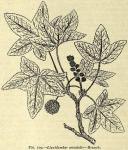201. Styrax.—Storax. Liquid storax.
 A balsam obtained from the wood and inner bark of Liquid'ambar orienta'lis Miller.
A balsam obtained from the wood and inner bark of Liquid'ambar orienta'lis Miller.
SOURCE AND DESCRIPTION.—This balsam is not a natural part of the plant but is produced as a result of the stimulus from wounds in the bark. The outer bark is bruised, then the inner bark becomes saturated with this pathological exudation. The outer bark is removed and the inner is boiled in sea water, the storax is skimmed off the surface as it rises, then afterward the boiled bark is pressed. The bark which yet contains some balsam is dried and used chiefly as incense. Good storax should not contain over 30 per cent. of water and 60 per cent. should be soluble in alcohol.
The Liquidambar orientalis, growing in the southwest districts of Asia Minor, produces the balsam also, it is said. It is a gigantic tree "like the great oak, having clusters (of berries) like those of the oak, but its berries are larger." The inner bark of the tree is boiled in water and the balsam pressed out. A superior kind is said to be obtained by simply pressing the bark before it is boiled. Another kind of liquid storax is mentioned-that which exudes naturally.
HABITAT.—Asia Minor.
DESCRIPTION OF DRUG.—It is a viscid, gray semi-liquid, with an agreeable odor, and a balsamic, somewhat acrid taste; a heavier dark brown layer separates on standing.
CONSTITUENTS.—Containing a volatile oil and a resin, and cinnamic and benzoic acids, storax is rightly classed as a balsam. Its most abundant constituent is storesin, C36H58O3, existing both free and as a cinnamic ether. Cinnamic acid exists to the extent of 6 to 12 per cent., various ethers of it occurring, styracin being the cinnamate of cinnamyl. Storax also contains a liquid hydrocarbon, styrol, C8H8, or cinnamene, having the storax odor and taste, and another fragrant constituent, vanillin, not more than 1 per cent. of ash.
ACTION AND USES.—Stimulant expectorant. Dose: 5 to 20 gr. (0.3 to 1.3 Gm.).
OFFICIAL PREPARATION.
Tinctura Benzoini Composita (8 per cent.), Dose: ½ to 2 fl. dr. (2 to 8 mils).

